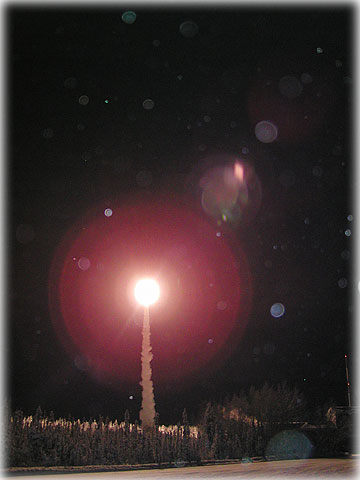 JOULE II rockets launch with
success
JOULE II rockets launch with
success
January 19, 2007
Friday
 This photo captures
the third rocket in the JOULE II series to launch January 19
from Poker Flat Research Range. As part of JOULE II, two pairs
of rockets were launched in a series. Each pair included a rocket
that released a trimethyl aluminum vapor that glowed in the upper
atmosphere, and another full of instruments to track the glowing
trails of the vapor as it moved in the winds 60 to 120 miles
above Earth.
This photo captures
the third rocket in the JOULE II series to launch January 19
from Poker Flat Research Range. As part of JOULE II, two pairs
of rockets were launched in a series. Each pair included a rocket
that released a trimethyl aluminum vapor that glowed in the upper
atmosphere, and another full of instruments to track the glowing
trails of the vapor as it moved in the winds 60 to 120 miles
above Earth.
Photo by Michael "Snap" Conger, Honeywell
|
From Poker Flat Research Range
north of Fairbanks, four NASA rockets launched into an aurora
display over northern Alaska, starting at 3:29 a.m. Alaska Standard
Time. Scientists hope to learn more about electrical heating
of the thin atmosphere from about 60 to 120 miles above Earth's
surface with the launch of these rockets. The project is called
JOULE II.
Staff at Poker Flat Research Range coordinated with the Federal
Aviation Administration to ensure that airspace was secure before
launching all rockets. Each rocket's flight lasted about 12 minutes,
and all rockets performed as planned, flying to their desired
locations in space, with precision greater than 95 percent.
Miguel Larsen, a professor at Clemson University, was the principal
investigator for JOULE II, which consisted of two Terrier Orions,
a Black Brant V, and a Black Brant IX. The rockets launched in
two pairs-the pairs consisted of one rocket with instruments
to read the detailed structure of the electrical currents within
the aurora, while a second rocket released a visible tracer of
trimethyl aluminum vapor to measure the winds and turbulence
at that altitude range.
Using sensitive digital and film cameras, scientists watching
from Poker Flat, Coldfoot, and Fort Yukon determined how winds
in the upper atmosphere contorted the visible tracer. They will
use the information to track the winds in the aurora region.
The two releases of trimethyl aluminum produced a milky white
glow when exposed to oxygen in the upper atmosphere, and may
have been visible over parts of Alaska.
The instrument packages within the rockets radioed down their
information about aurora currents as they flew through them.
The rocket payloads landed in locations between Fort Yukon and
Arctic Village.
Poker Flat Research Range is operated by the Geophysical Institute
at the University of Alaska Fairbanks, under contract to NASA.
Scientific sounding rockets have launched from the facility since
1969.
Source of News:
Geophysical Institute at the
University of Alaska Fairbanks
www.gi.alaska.edu
E-mail your news &
photos to editor@sitnews.us
Publish A Letter on SitNews Read Letters/Opinions
Contact the Editor
SitNews
©2006
Stories In The News
Ketchikan, Alaska
|

